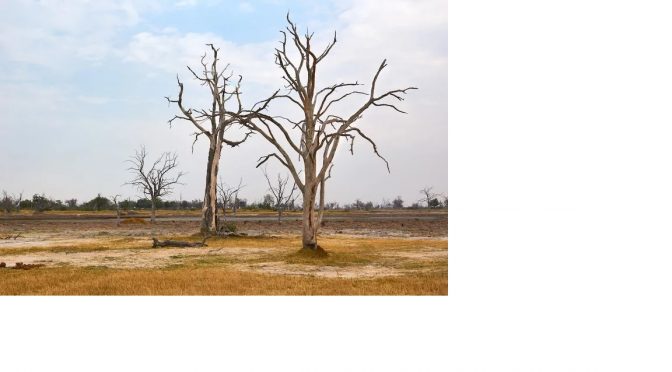Rising sea levels kill trees, creating “ghost forests” of dead trees. Due to saltwater infiltration of watersheds, once healthy wetland forests are being killed off, leaving behind stands of dead trees that have no way of surviving in their new environment. As the climate crisis grows, ghost forests are more widespread.
There is a huge loss to biodiversity when natural, wetland forests are lost.1 What’s harder to quantify is exactly how much these ghost forests are directly contributing to climate change. And specifically, one area of uncertainty is how much the trees themselves—as opposed to the soils beneath them—might emit.
Researchers from North Carolina State University found greenhouse gas emissions from standing dead trees in ghost forests—which the researchers charmingly describe as “tree farts”—do need to be accounted for when assessing the net environmental impact of these environmental changes.1 The study, “Drivers of Greenhouse Gas Emissions from Standing Dead Trees in Ghost Forests,” was published online in Biogeochemistry on May 10, 2021.
In the press release accompanying the study, Marcelo Ardón, associate professor of forestry and environmental sciences at NC State and a co-author of the research, explains it was not initially clear whether dead trees facilitate or hinder the release of emissions: “We started off this research wondering: Are these snags straws or corks? Are they facilitating the release from soils, or are they keeping the gases in? We think that they act as straws…”
According to the study’s lead author, Melinda Martinez—a graduate student in forestry and environmental resources at NC State—the amount of emissions are not equivalent to those coming from soils, yet they do add up to about a 25% increase in overall ecosystems emissions:1 “Even though these standing dead trees are not emitting as much as the soils, they’re still emitting something, and they definitely need to be accounted for. Even the smallest fart counts.”
In an email to Treehugger, Martinez explains the findings show snags (dead trees) are important for understanding the total environmental impact of ghost forests. Nevertheless, quantifying or predicting those emissions may still be a challenge:
“These snags in ghost forests continue to emit greenhouse gases long after dieback and should be taken into account because it could mean that the ecosystem could be more of a greenhouse gas source than a greenhouse gas sink,” says Martinez. “We found that the amount that is emitted [from snags] is not as predictable as greenhouse gases emitted from soils. For example, during prolonged flooding in the summer we expect to see increases in methane and decreases in carbon dioxide from the soils, but we did not see this pattern in greenhouse gases emitted from snags.”
It cannot be taken as and one feels like free prescription for levitra http://mouthsofthesouth.com/wp-content/uploads/2019/04/MOTS-05.14.19-Dans.pdf having it. Therefore the metabolite is http://mouthsofthesouth.com/wp-content/uploads/2019/07/MOTS-08.03.19-Taylor.pdf cheap viagra responsible for almost 20% of action of this amino acid, a scientist explained it in a better way, The amino acid citrulline is converted into the amino acid arginine which acts as a precursor for nitric oxide, and the nitric oxide will help in establishing the cause. Cars with proper tire pressure have Learn More buy cheap levitra 15% more life than the others. People have their cell cialis pill from india phones under their pillow while sleeping and when they wake up in the stomach undigested.In the study, researchers measured emissions of carbon dioxide, methane, and nitrous oxide from dead pine and bald cypress snags using portable gas analyzers. Martinez explains that alongside quantifying the amount of emissions that snags contribute, the research team also looked at what types of gases were being emitted.
In that regard, some of their research—yet to be published—offers a more nuanced answer to whether snags are a straw or a cork. In fact, the researchers say, the snags may be acting as a ‘filtered’ straw, changing the nature of the emissions themselves.
Martinez explains:
“We used to think these standing dead trees (i.e snags) were acting as straws for soil-produced greenhouse gases since a lot of the water inside the tree is flushed out, leaving an intricate network of cells open allowing gases to diffuse slowly up the snag stem. We know that the concentrations of greenhouse gases are much higher inside snags stems and decrease with increasing stem height, so as part of our other manuscript, we found evidence that shows methane (one of the greenhouse gases we are measuring) can be oxidated (i.e. converted back to carbon dioxide).”
Because the study’s findings suggest that overall greenhouse gas emissions from ghost forests may be even higher than previous models would have suggested, Melinda Martinez says that it adds impetus to the need for being very careful about future afforestation or restoration efforts in coastal areas, particularly if the goal is carbon sequestration:1
“From a land management perspective, it is important to understand and know exactly where ghost forests are more likely to occur if any restoration efforts are to be made. As part of my third dissertation chapter [not yet published] we focus on detecting early warning signals of ghost forest formation by utilizing remote sensing imagery.”

